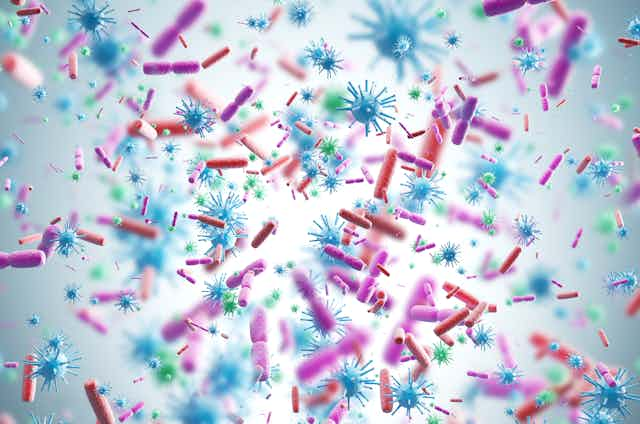A lot has been written and said about the gut microbiome – the community of bacteria, viruses, fungi and archaea that lives in our intestines. But the gut is not the only place that has a microbiome. The mouth, nose, skin, lungs and genitals have microbiomes of their own. And they all play an important role in our health.
Here is a brief introduction to each one.
Oral microbiome
Arguably, this was the first microbiome discovered.
In the late 1600s, Antonie van Leeuwenhoek, a Dutch scientist, scraped the inside of his mouth and examined the contents under a microscope. There he found “many very little living animalcules, very prettily a-moving”. Today, we know that there are more than just “animalcules”, as Van Leeuwenhoek called bacteria, but fungi and viruses too.
This collection of microbes, among other things, aids digestion by breaking down complex carbohydrates into simpler sugars so that the gut can more easily absorb them.
As with all microbiomes, the oral microbiome competes with harmful bacteria for resources and space. When the balance of microorganisms in the mouth is disrupted, it can lead to cavities, gum disease and infections.
Good oral hygiene and a healthy diet can ensure that good microbes prevail.
Nasal microbiome
Moving north, we find the nasal microbiome, which helps to filter and trap particles from the air we breathe.
While the nasal microbiome has over a hundred strains of bacteria, only two to ten species make up 90% of the microbiome.
These bacteria have a symbiotic relationship – you scratch my back and I’ll scratch yours. However, imbalances in the nasal microbiome can occur as a result of environmental exposures (such as air pollution), genetics or problems with our immune system. These imbalances have been linked to conditions such as chronic sinusitis, nasal allergies and a higher risk of respiratory infections.
A small study from Portugal found that wine tasters have fewer nasal bacteria and less diverse bacterial species than non-wine tasters. One of the researchers, Lucía Perez-Pardal, told New Scientist that the alcohol molecule dehydrates bacteria. “It removes water from their membranes and they explode,” Perez-Pardal said. “If you kill the bacteria often, you don’t give enough time for repopulation.”

Skin microbiome
A complex community of microorganisms lives on our skin’s surface and deeper layers.
The skin microbiome includes bacteria, fungi and viruses. These microorganisms play an important role in keeping our skin healthy and protecting against harmful bacteria.
Imbalances in the skin microbiome have been associated with skin conditions like acne, eczema, psoriasis and dermatitis.
A study published earlier this year, which is yet to be peer-reviewed, found that two bacterial species, Cutibacterium acnes and Staphylococcus epidermidis were associated with a decline in collagen levels – the scaffolding that keeps your skin young-looking. Expect new anti-ageing treatments that target these bugs to be on the market shortly.
Lung microbiome
The one part of the body that was long thought to be sterile turns out to have a microbiome too. The lung microbiome is not as diverse as the other biomes, mainly consisting of bacteria.
It is believed that these bacteria come from the mouth and nose, making their way into the lungs when we inhale small amounts of oral and nasal secretions.
The lung microbiome plays a role in immune responses and respiratory health. Disruptions in the lung microbiome can make us more susceptible to infections and respiratory diseases such as asthma, chronic obstructive pulmonary disease (COPD) and pneumonia.
Genital microbiome
Heading further south, we have the vaginal microbiome in females and the penile microbiome in males.
In females, the vaginal microbiome is mainly composed of bacteria, particularly Lactobacillus species. This microbiome helps maintain a healthy vagina by creating an acidic environment that prevents the growth of harmful bacteria and promotes a balanced microbial community.
When the vaginal microbiome is out of balance, it can lead to conditions such as bacterial vaginosis and yeast infections.
The penile microbiome in males also contributes to genital health, although it has been less extensively studied.
Imbalances in the penile microbiome might lead to conditions such as urinary tract infections.
Gut microbiome
The gut microbiome is one of the most well-known and influential microbiomes in our bodies. It’s a vast collection of microorganisms, including bacteria, viruses, fungi and archaea.
The gut microbiome is essential for digestion, metabolism and developing our immune system. It helps break down complex carbohydrates, produces vitamins, including vitamin K and various B vitamins, and helps us absorb nutrients.
Imbalances in the gut microbiome have been linked to conditions like inflammatory bowel diseases, obesity, type 2 diabetes, and mental health disorders, such as depression and anxiety.
There are various ways to keep the gut microbiome healthy or rebalance it when it gets out of whack. These include taking probiotics (beneficial bacteria) and prebiotics (fibres that feed the bacteria). It can also be done with a faecal microbiota transplant (transferring healthy microbiota from a donor to a recipient), also known as a poo transplant.
These biomes in our bodies are not isolated entities. They interact with each other in complex ways. For example, the oral and nasal microbiomes can affect the health of our respiratory system.
Disruptions in the gut microbiome can influence our immune system and affect other biomes. The skin microbiome can interact with the genital microbiome and with microbes from our environment.
Recognising the interconnectedness of these biomes reminds us that our body is a holistic ecosystem where imbalances in one area can have consequences throughout the entire microbial landscape. Understanding these interactions opens up new avenues for improving people’s health.

